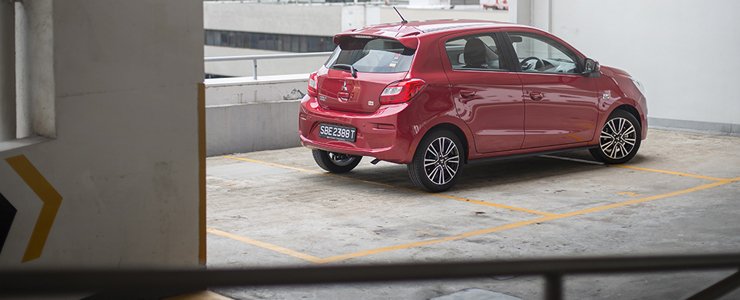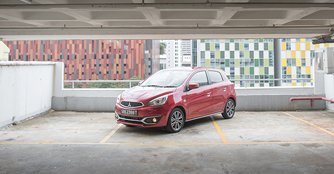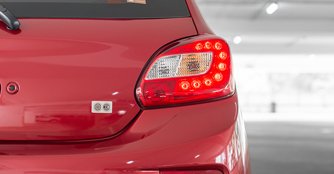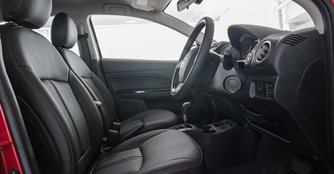Mitsubishi Space Star 1.2 (A) Review
02 May 2017|65,351 views
What We Like
4.6m turning radius is even smaller than the Attrage's 4.8m
Impressive 14km/L fuel economy
More SRS airbags than the Mazda2 and Nissan Note
What We Dislike
Takes a while to get up to speed
Cabin is a tad tacky
Starting a family in Singapore is no walk in the park. Wedding plans aside, the cost of a Built-to-Order (BTO) flat, on top of saving for your future child's education, medical and child care expenses are reason enough to stay single.
Still, we are a pro-natalist society and settling down is just what we do. Following a BTO, the next logical purchase would be a small family car.
As a first car for a small family, it doesn't need to be a seven-seater, have a powerful engine or have fancy features like ventilated seats and a snazzy infotainment system.
It just needs to get your family from point A to point B. More importantly, it has to be affordable.
Bigger isn't always better
We thought the Mitsubishi Attrage was easy to manoeuvre, with its 4.8m turning radius and modest size of just 4,245mm x 1,670mm x 1,515mm (L x W x H), until we met the Space Star.
Measuring in at just 3,795mm x 1,665mm x 1,510mm with a 4.6m turning radius, this compact hatchback zips around town, through tiny alleys and up the narrowest of carpark ramps effortlessly.
Despite its size, the Space Star still offers a decent amount of space. It's not the roomiest cabin but it is able to seat four adults in relative comfort.
Its compactness also helps its strong air-conditioning to circulate cool air more quickly, especially useful in our tropical climate.
Still, we are a pro-natalist society and settling down is just what we do. Following a BTO, the next logical purchase would be a small family car.
As a first car for a small family, it doesn't need to be a seven-seater, have a powerful engine or have fancy features like ventilated seats and a snazzy infotainment system.
It just needs to get your family from point A to point B. More importantly, it has to be affordable.
Bigger isn't always better
We thought the Mitsubishi Attrage was easy to manoeuvre, with its 4.8m turning radius and modest size of just 4,245mm x 1,670mm x 1,515mm (L x W x H), until we met the Space Star.
Measuring in at just 3,795mm x 1,665mm x 1,510mm with a 4.6m turning radius, this compact hatchback zips around town, through tiny alleys and up the narrowest of carpark ramps effortlessly.
Despite its size, the Space Star still offers a decent amount of space. It's not the roomiest cabin but it is able to seat four adults in relative comfort.
Its compactness also helps its strong air-conditioning to circulate cool air more quickly, especially useful in our tropical climate.
Underneath its petite exterior, you'll discover a surprisingly spacious 416-litre boot capable of accommodating a week's worth of groceries, with room to spare.
Compartments strewn about the cabin also provide convenient storage for water bottles, smartphones, and other bits and bobs.

 The optional locally fitted Sony head unit offers Bluetooth audio, navigation, Android Auto and Apple CarPlay
The optional locally fitted Sony head unit offers Bluetooth audio, navigation, Android Auto and Apple CarPlay
Down on size, down on price
Coming in at $82,999 (as of 13th April 2017), the Mitsubishi Space Star is more affordable than the Mazda2 and the Nissan Note, both of which cost upwards of $90,000, depending on the trim level.
That doesn't make it any less of a car. In fact, the Space Star boasts six SRS airbags while the Mazda2, the Nissan Note and the Mitsubishi Attrage only have two each.
It also features 15-inch alloy wheels, automatic rain sensors and automatic head lights as standard. What doesn't come standard is the Sony infotainment system, which came equipped in our test car.
Compartments strewn about the cabin also provide convenient storage for water bottles, smartphones, and other bits and bobs.

Down on size, down on price
Coming in at $82,999 (as of 13th April 2017), the Mitsubishi Space Star is more affordable than the Mazda2 and the Nissan Note, both of which cost upwards of $90,000, depending on the trim level.
That doesn't make it any less of a car. In fact, the Space Star boasts six SRS airbags while the Mazda2, the Nissan Note and the Mitsubishi Attrage only have two each.
It also features 15-inch alloy wheels, automatic rain sensors and automatic head lights as standard. What doesn't come standard is the Sony infotainment system, which came equipped in our test car.
 |
Locally fitted leather seats are relatively comfortable for short stints around town while a high seating position in the front provides excellent visibility of the road ahead.
We didn't manage to get anywhere close to the Space Star's claimed 23.3km/L fuel economy figure but we did manage an impressive 14km/L during our time with it. In comparison, we managed 13.5km/L in the larger and heavier Attrage.
Made for the city, not the track
Putting out 78bhp and 100Nm of torque, the naturally aspirated 1.2-litre three-cylinder engine - which is mated to a CVT transmission - makes the Space Star one of the more frugal options out there.
The downside, however, is that the car does require some coaxing and advance planning in order to overtake vehicles on the highway.
We didn't manage to get anywhere close to the Space Star's claimed 23.3km/L fuel economy figure but we did manage an impressive 14km/L during our time with it. In comparison, we managed 13.5km/L in the larger and heavier Attrage.
Made for the city, not the track
Putting out 78bhp and 100Nm of torque, the naturally aspirated 1.2-litre three-cylinder engine - which is mated to a CVT transmission - makes the Space Star one of the more frugal options out there.
The downside, however, is that the car does require some coaxing and advance planning in order to overtake vehicles on the highway.
Driven thus, you get a fair amount of road and wind noise but it's never unbearable.
Urban warrior in full effect
Unless you're descended from a long line of multi-billionaires, an overpowered, fully-featured track beast probably wouldn't make it onto your shortlist of first family cars.
That said, if you're looking for an affordable point A to point B car, which is easy to navigate through city traffic yet provides enough space and safety for a small family, then look no further.
At this price point, few cars offer as much bang for the buck as the Mitsubishi Space Star, one that makes for a great fuss-free first family car.
Urban warrior in full effect
Unless you're descended from a long line of multi-billionaires, an overpowered, fully-featured track beast probably wouldn't make it onto your shortlist of first family cars.
That said, if you're looking for an affordable point A to point B car, which is easy to navigate through city traffic yet provides enough space and safety for a small family, then look no further.
At this price point, few cars offer as much bang for the buck as the Mitsubishi Space Star, one that makes for a great fuss-free first family car.
What We Like
4.6m turning radius is even smaller than the Attrage's 4.8m
Impressive 14km/L fuel economy
More SRS airbags than the Mazda2 and Nissan Note
What We Dislike
Takes a while to get up to speed
Cabin is a tad tacky
Starting a family in Singapore is no walk in the park. Wedding plans aside, the cost of a Built-to-Order (BTO) flat, on top of saving for your future child's education, medical and child care expenses are reason enough to stay single.
Still, we are a pro-natalist society and settling down is just what we do. Following a BTO, the next logical purchase would be a small family car.
As a first car for a small family, it doesn't need to be a seven-seater, have a powerful engine or have fancy features like ventilated seats and a snazzy infotainment system.
It just needs to get your family from point A to point B. More importantly, it has to be affordable.
Bigger isn't always better
We thought the Mitsubishi Attrage was easy to manoeuvre, with its 4.8m turning radius and modest size of just 4,245mm x 1,670mm x 1,515mm (L x W x H), until we met the Space Star.
Measuring in at just 3,795mm x 1,665mm x 1,510mm with a 4.6m turning radius, this compact hatchback zips around town, through tiny alleys and up the narrowest of carpark ramps effortlessly.
Despite its size, the Space Star still offers a decent amount of space. It's not the roomiest cabin but it is able to seat four adults in relative comfort.
Its compactness also helps its strong air-conditioning to circulate cool air more quickly, especially useful in our tropical climate.
Still, we are a pro-natalist society and settling down is just what we do. Following a BTO, the next logical purchase would be a small family car.
As a first car for a small family, it doesn't need to be a seven-seater, have a powerful engine or have fancy features like ventilated seats and a snazzy infotainment system.
It just needs to get your family from point A to point B. More importantly, it has to be affordable.
Bigger isn't always better
We thought the Mitsubishi Attrage was easy to manoeuvre, with its 4.8m turning radius and modest size of just 4,245mm x 1,670mm x 1,515mm (L x W x H), until we met the Space Star.
Measuring in at just 3,795mm x 1,665mm x 1,510mm with a 4.6m turning radius, this compact hatchback zips around town, through tiny alleys and up the narrowest of carpark ramps effortlessly.
Despite its size, the Space Star still offers a decent amount of space. It's not the roomiest cabin but it is able to seat four adults in relative comfort.
Its compactness also helps its strong air-conditioning to circulate cool air more quickly, especially useful in our tropical climate.
Underneath its petite exterior, you'll discover a surprisingly spacious 416-litre boot capable of accommodating a week's worth of groceries, with room to spare.
Compartments strewn about the cabin also provide convenient storage for water bottles, smartphones, and other bits and bobs.
Down on size, down on price
Coming in at $82,999 (as of 13th April 2017), the Mitsubishi Space Star is more affordable than the Mazda2 and the Nissan Note, both of which cost upwards of $90,000, depending on the trim level.
That doesn't make it any less of a car. In fact, the Space Star boasts six SRS airbags while the Mazda2, the Nissan Note and the Mitsubishi Attrage only have two each.
It also features 15-inch alloy wheels, automatic rain sensors and automatic head lights as standard. What doesn't come standard is the Sony infotainment system, which came equipped in our test car.
Compartments strewn about the cabin also provide convenient storage for water bottles, smartphones, and other bits and bobs.
Down on size, down on price
Coming in at $82,999 (as of 13th April 2017), the Mitsubishi Space Star is more affordable than the Mazda2 and the Nissan Note, both of which cost upwards of $90,000, depending on the trim level.
That doesn't make it any less of a car. In fact, the Space Star boasts six SRS airbags while the Mazda2, the Nissan Note and the Mitsubishi Attrage only have two each.
It also features 15-inch alloy wheels, automatic rain sensors and automatic head lights as standard. What doesn't come standard is the Sony infotainment system, which came equipped in our test car.
Locally fitted leather seats are relatively comfortable for short stints around town while a high seating position in the front provides excellent visibility of the road ahead.
We didn't manage to get anywhere close to the Space Star's claimed 23.3km/L fuel economy figure but we did manage an impressive 14km/L during our time with it. In comparison, we managed 13.5km/L in the larger and heavier Attrage.
Made for the city, not the track
Putting out 78bhp and 100Nm of torque, the naturally aspirated 1.2-litre three-cylinder engine - which is mated to a CVT transmission - makes the Space Star one of the more frugal options out there.
The downside, however, is that the car does require some coaxing and advance planning in order to overtake vehicles on the highway.
We didn't manage to get anywhere close to the Space Star's claimed 23.3km/L fuel economy figure but we did manage an impressive 14km/L during our time with it. In comparison, we managed 13.5km/L in the larger and heavier Attrage.
Made for the city, not the track
Putting out 78bhp and 100Nm of torque, the naturally aspirated 1.2-litre three-cylinder engine - which is mated to a CVT transmission - makes the Space Star one of the more frugal options out there.
The downside, however, is that the car does require some coaxing and advance planning in order to overtake vehicles on the highway.
Driven thus, you get a fair amount of road and wind noise but it's never unbearable.
Urban warrior in full effect
Unless you're descended from a long line of multi-billionaires, an overpowered, fully-featured track beast probably wouldn't make it onto your shortlist of first family cars.
That said, if you're looking for an affordable point A to point B car, which is easy to navigate through city traffic yet provides enough space and safety for a small family, then look no further.
At this price point, few cars offer as much bang for the buck as the Mitsubishi Space Star, one that makes for a great fuss-free first family car.
Urban warrior in full effect
Unless you're descended from a long line of multi-billionaires, an overpowered, fully-featured track beast probably wouldn't make it onto your shortlist of first family cars.
That said, if you're looking for an affordable point A to point B car, which is easy to navigate through city traffic yet provides enough space and safety for a small family, then look no further.
At this price point, few cars offer as much bang for the buck as the Mitsubishi Space Star, one that makes for a great fuss-free first family car.
Car Information
Mitsubishi Space Star
CAT A|Petrol|21.2km/L
Horsepower
58kW (78 bhp)
Torque
100 Nm
Acceleration
13.8sec (0-100km /hr)
Thank You For Your Subscription.







































